Book now
So much to see and so little time! Spend the night in Mechelen or take a guided tour…
Sint-Romboutstoren: An Iconic Symbol of Mechelen
Mechelen is a charming city that is home to many fascinating historical landmarks, including the magnificent Sint-Romboutstoren. This Gothic-style tower dominates the skyline of Mechelen, standing tall at over 97 meters high. It is one of the most iconic structures in the city and has been a source of fascination for visitors and locals alike for centuries. From its impressive bells to its breathtaking views, the Sint-Romboutstoren has something to offer everyone. In this article, we’ll take a closer look at the history, design, and significance of this incredible tower, as well as offer some tips for those looking to climb to the top. So, let’s dive into the world of Sint-Romboutstoren and discover why it is such an essential part of Mechelen’s heritage.
Location: Onder den Toren 12, 2800 Mechelen
Short of time to read the whole article? Go directly to your favorite topic via the table of contents.
Sint-Romboutskathedraal
The Sint-Romboutskathedraal, also known as the Cathedral of St. Rumbold, is a magnificent Gothic cathedral located in the heart of Mechelen. The cathedral is named after St. Rumbold, the patron saint of the city, and is considered one of the most important religious landmarks in Belgium.
The cathedral was originally built in the 13th century, but was later expanded and renovated in the 14th and 15th centuries. Its iconic tower, which stands at over 97 meters tall, was added in the mid-16th century and is one of the tallest towers in Belgium.
Visitors to the Sint-Romboutskathedraal can admire its breathtaking Gothic architecture, including its intricate stained glass windows, ornate carvings, and soaring arches. The cathedral also houses a number of important artworks, including paintings by famous Flemish artists such as Anthony van Dyck and Peter Paul Rubens.
One of the highlights of a visit to the Sint-Romboutskathedraal is climbing to the top of the tower, where visitors can enjoy panoramic views of the city of Mechelen and the surrounding countryside. The climb is a challenging one, with over 538 steps leading to the top, but is well worth the effort for the stunning views it offers.
The entrance to the Cathedral of St.Rumbold is free.







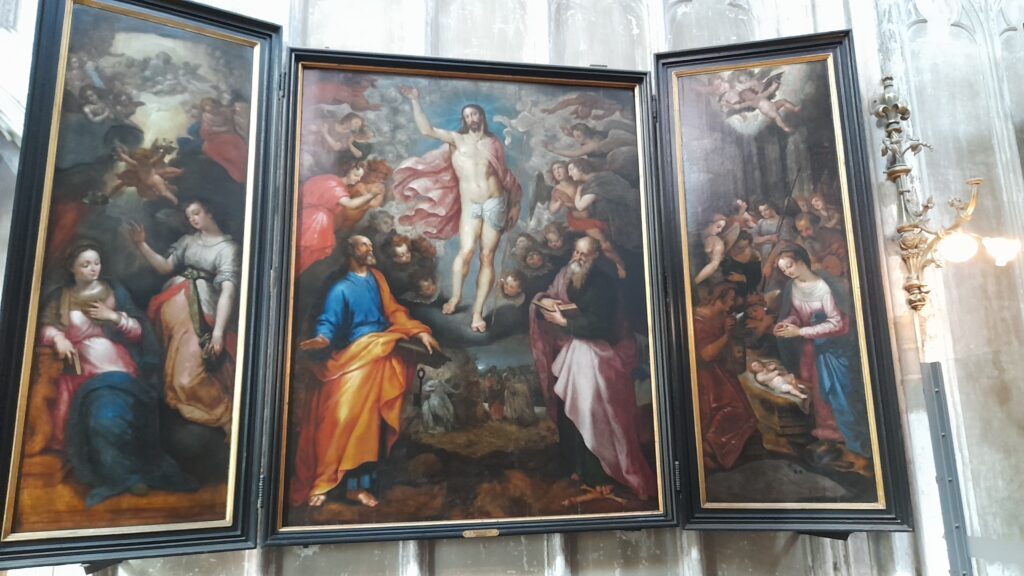

The Design and Architecture of Sint-Romboutstoren
The Sint-Romboutstoren is a towering example of Gothic architecture and design. The tower was constructed over the course of several centuries, beginning in the early 14th century and continuing through the 16th century. The tower’s overall style is primarily Gothic, with pointed arches, intricate carvings, and towering spires.
At 97.28 meters tall, the Sint-Romboutstoren is the tallest church tower in Belgium and one of the tallest in Europe. The tower is comprised of several different sections, each with its own unique design and architectural features. The lower section of the tower is made up of three square levels, each adorned with pointed arches and intricate stone carvings. The fourth level is an octagonal section, which gives way to a massive, Gothic-style spire that rises high into the sky.
One of the most striking features of the Sint-Romboutstoren is its carillon, which is one of the most extensive and impressive in the world. The carillon consists of a total of 49 bells, with the largest weighing in at over 8,000 kilograms. The bells are housed in the upper section of the tower and are played by a skilled carillonneur, who uses a keyboard to create beautiful, melodic tones.
Overall, the design and architecture of the Sint-Romboutstoren are a testament to the skill and artistry of the craftsmen who built it. The tower is a true masterpiece of Gothic architecture and design, and it continues to amaze and inspire visitors to this day.
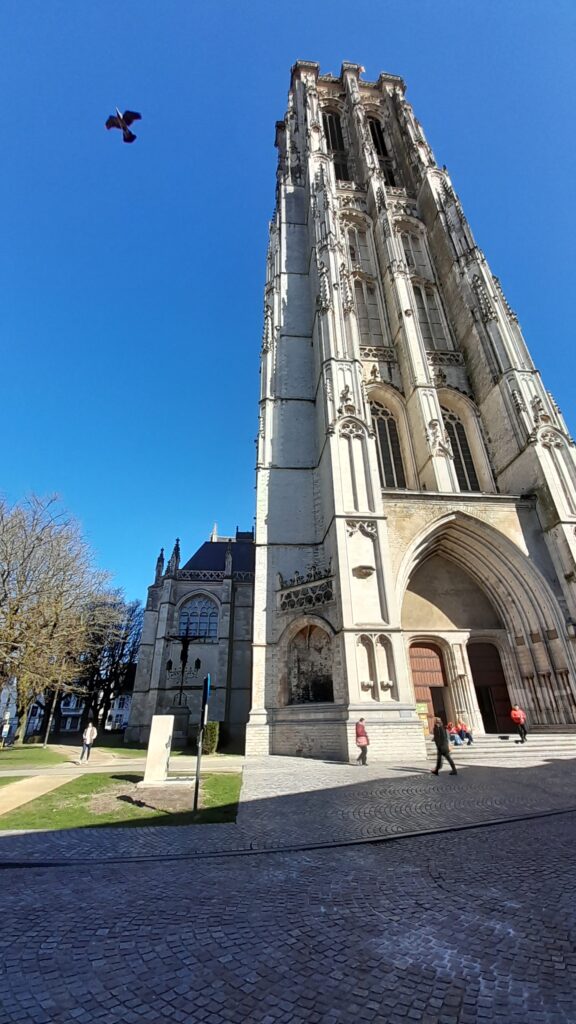



The History of Sint-Romboutstoren
The history of the Sint-Romboutstoren is deeply intertwined with the history of Mechelen itself. The tower was originally constructed in the early 14th century as part of the Sint-Romboutskathedraal (St. Rumbold’s Cathedral), which was being built at the time. However, it was not until the 16th century that the tower was completed with its spire.
Over the centuries, the Sint-Romboutstoren has played a significant role in the history of Mechelen. In the 16th century, it served as a watchtower for the city, allowing guards to keep an eye out for approaching enemies. During this time, the tower also played a role in the religious and political upheavals that were taking place in the region.
Today, the Sint-Romboutstoren remains a symbol of Mechelen’s rich history and heritage. It is a beloved landmark and a popular destination for visitors from all over the world. Whether you’re interested in the tower’s religious significance, its architectural marvels, or its role in Mechelen’s past, the Sint-Romboutstoren is a fascinating monument that is sure to captivate and inspire.
Climbing the Sint-Romboutstoren
For those with a sense of adventure and a desire to see Mechelen from a different perspective, climbing the Sint-Romboutstoren is an absolute must-do experience. The climb to the top of the tower is not for the faint of heart, but the stunning views of the city and the surrounding countryside are more than worth the effort.
The climb to the top of the Sint-Romboutstoren is a total of 538 steps, but there are several stopping points along the way where visitors can catch their breath and take in the views. The climb is not suitable for those with mobility issues or young children, and visitors are advised to wear comfortable shoes and clothing.
Once you reach the top of the tower, you will be rewarded with panoramic views that stretch for miles in every direction. On a clear day, you can see all the way to Brussels and Antwerp, and the views of Mechelen itself are simply breathtaking. The experience of standing atop one of Belgium’s tallest church towers is truly unforgettable, and it is a memory that you will cherish for a lifetime.
If you’re planning on climbing the Sint-Romboutstoren, be sure to check the tower’s opening hours in advance. The tower is typically open to visitors during the summer months, but it may be closed during certain periods for maintenance or other reasons. Additionally, visitors should be aware that the climb to the top of the tower can be strenuous, and it is not recommended for those who are not comfortable with heights or strenuous physical activity.
Climbing the Sint-Romboutstoren is an incredible experience that should not be missed by anyone visiting Mechelen. The tower’s history, architecture, and stunning views make it a truly unique destination that is sure to leave a lasting impression.




Kraankamer
The Kraankamer, or “Crane Room” in English, is a fascinating piece of history that is located within the Sint-Romboutstoren. The room gets its name from the fact that it was once used to operate a large wooden crane that was used to hoist heavy materials up to the top of the tower during its construction.
The Kraankamer is one of the tower’s most unique and interesting features. Visitors can see the remains of the wooden crane, which was used to transport heavy building materials such as stones and bricks up to the top of the tower. The room also contains several other historical artifacts and displays, including old photographs and drawings of the tower throughout its construction and history.






Smidse
The “smidse” is a blacksmith shop that is located within the Sint-Romboutstoren. This unique feature of the tower provides visitors with a glimpse into the tower’s past when it was used as a hub of activity for craftsmen.
The smidse is located on the tower’s second level. It was used by blacksmiths to create tools and other items necessary for the construction of the tower. The room is also filled with several other historical artifacts and displays.
In addition to its historical significance, the smidse is also noteworthy for its impressive craftsmanship. The tools and equipment on display within the room provide visitors with a real sense of the skill and dedication required to build such a magnificent tower.
The smidse is a fascinating feature of the Sint-Romboutstoren that offers visitors a unique look into the tower’s past.




Oude Beiaardkamer
The Oude Beiaardkamer, or “Old Carillon Room” in English, is another interesting feature of the Sint-Romboutstoren. The room was once home to the tower’s original carillon, which was installed in the late 17th century and remained in use until the mid-20th century.
The Oude Beiaardkamer is one of the tower’s most historic rooms. Visitors can see the original wooden beams and carillon equipment, as well as a number of other artifacts related to the tower’s musical history.
In addition to its historical significance, the Oude Beiaardkamer is also noteworthy for its impressive acoustics. The room’s high ceilings and wooden beams create a unique sound that is perfect for music performances, and it is still used for concerts to this day.


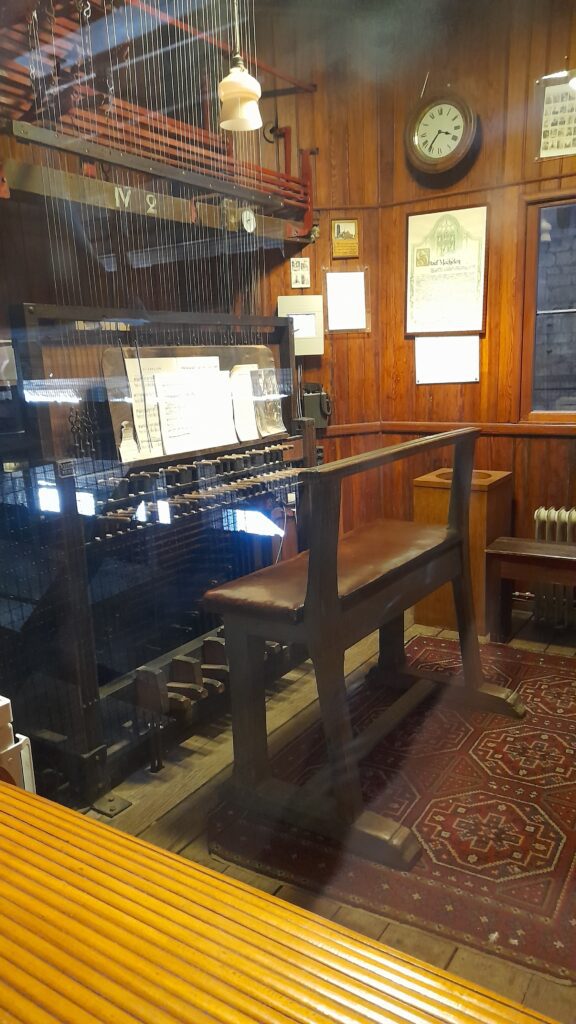

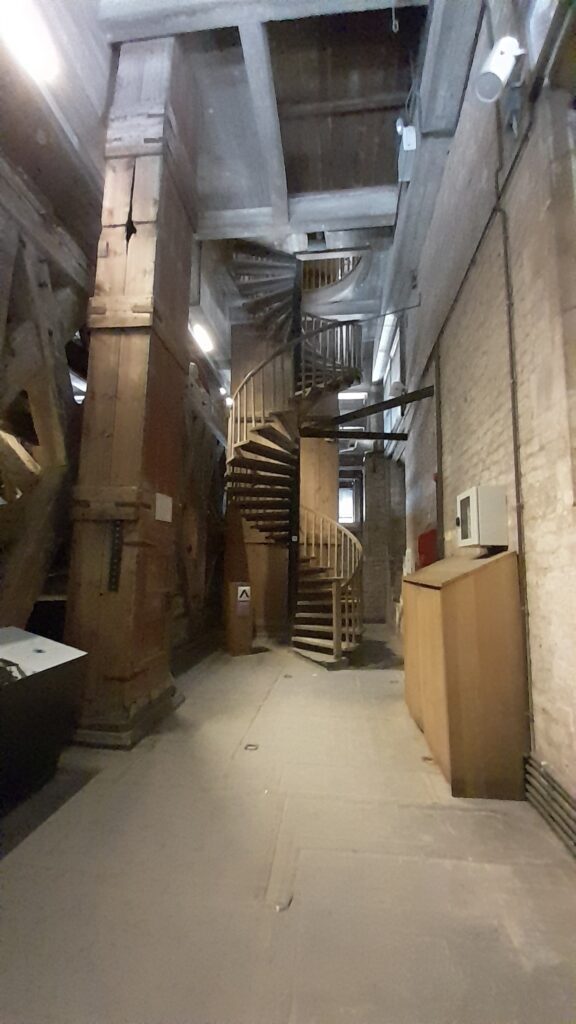

Uurwerkkamer
The Uurwerkkamer, or “Clock Room” in English, is another intriguing feature of the Sint-Romboutstoren. This room is dedicated to the tower’s impressive clock mechanism, which has been keeping time for over four centuries.
In addition to its historical significance, the Uurwerkkamer is also noteworthy for its impressive engineering. The clock mechanism is a marvel of medieval technology, featuring intricate gears and mechanisms that are still in working order to this day.






Nieuwe Beiaard






Askelder
Askelder is the name of the top floor of the Sint-Romboutstoren where workers used to store the cement for building the tower.
Visitors can see the original wooden floorboards and support beams, as well as several other artifacts related to the tower’s construction history.
In addition to its historical significance, the Askelder is also noteworthy for its impressive views. Visitors can climb to the top of the tower and enjoy panoramic views of the city of Mechelen and the surrounding countryside.


Skywalk


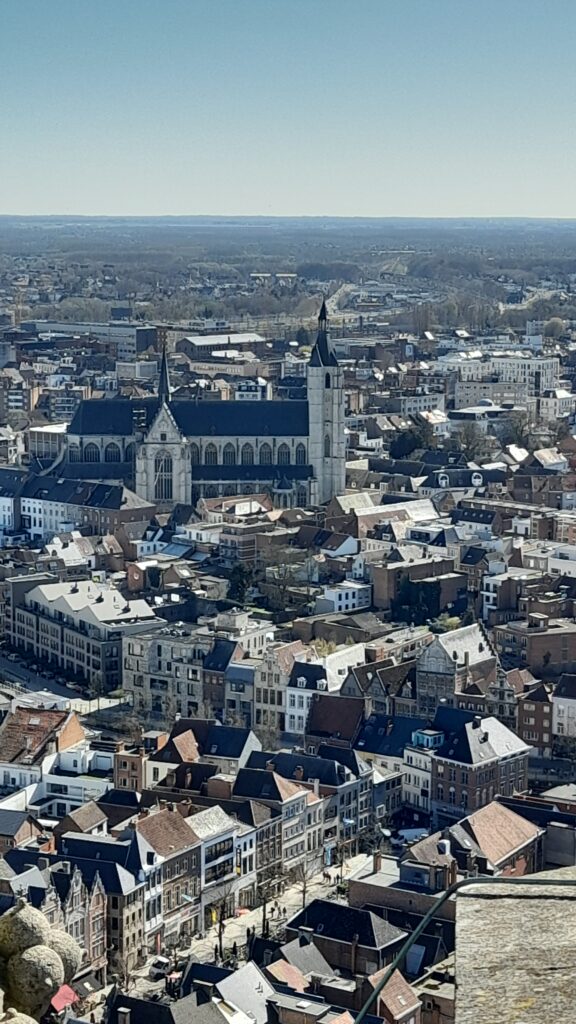







Opening hours
Individual visitors:
Sunday to Friday from 1 pm to 6 pm
Saturday from 10 am to 6 pm
Last ascent at 5 pm
closed on 25.12 and 01.01
Prices
Adults: € 8
Groups 10 or more pers.: € 6
children and young people from 4 to 27 years: € 3
Have you climbed St. Rumbold’s Tower? Then you get some more benefits with your ticket! Here’s how you’ll receive:
Discount on a visit to the Museum Hof van Busleyden.
Group rate on your tickets for a boat trip.
Discount on your tickets for the Toy Museum.
A free drink (excl. cava) for the whole team at De Gouden Kooi escape rooms.
Conclusion
The Sint-Romboutstoren is an iconic landmark of Mechelen and holds great cultural and historical significance for the people of the city. As one of the tallest and most recognizable structures in the area, it has played a vital role in shaping the city’s skyline and identity.
For visitors, a visit to the tower is a must-do experience. From the top of the tower, one can enjoy breathtaking views of the city and the surrounding areas. Additionally, the tower provides visitors with a glimpse into the rich history and architecture of the region.
During the climb to the top, visitors can also appreciate the tower’s intricate construction and the impressive feat of engineering it represents. The tower has withstood the test of time and serves as a testament to the skilled craftsmen who built it.
A visit to the Sint-Romboutstoren offers a unique and unforgettable experience that is not to be missed. Whether you are a history buff, an architecture enthusiast, or simply looking to enjoy stunning views of Mechelen, the tower is a must-see attraction.
People also read:
Spend the night in Mechelen
Booking.comMore usefull information and links
Get more out of your visit by searching and exploring the following information and website links
- St. Rumbold’s Cathedral
- Mechelen City Hall
- Kazerne Dossin – Memorial, Museum, and Documentation Centre on Holocaust and Human Rights
- Mechelen Toy Museum
- Palace of Margaret of Austria
- Mechelen’s Beguinage
- Het Anker Brewery
- Vismarkt (Fish Market)
- Vrijbroekpark
- Mechelen’s Great Market Square
- Hof van Busleyden Museum
- Mechelen’s City Museum
- Brouwerij de Kroon
- Mechelen’s Bell Tower
- Schoenhof’s Historical Museum
FAQ
written by Johnny
This article may contain affiliate links. This means that we receive a small commission when you book something via these links. Of course, this does not cost you anything extra. Did our tips help you? We would love it if you book your trip via the links in the article above. Thank you so much.
Read more articles on my Mechelen page.